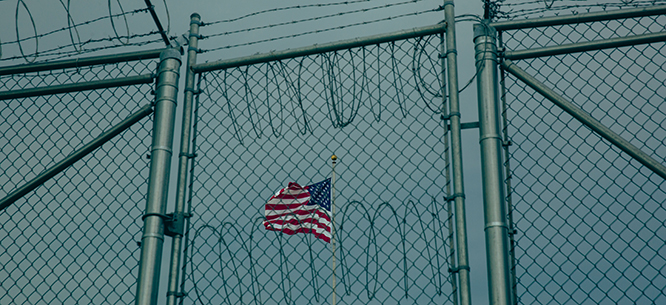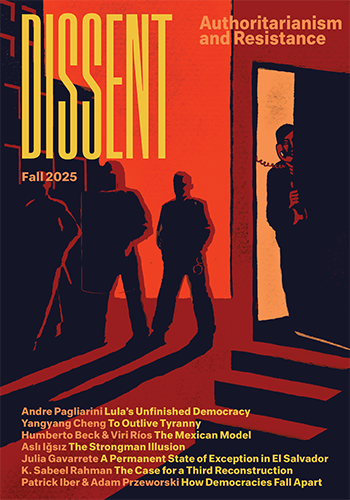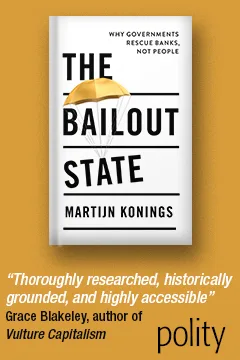“The Worst of the Worst”
“The Worst of the Worst”
Guantánamo represents a place beyond the reach of morality and the law, where America’s most dangerous enemies can be thrown, never to be seen again.

It’s hard to shake the feeling that Donald Trump is racing through the playbook of early twentieth-century U.S. imperialism. He began by threatening to annex Greenland for its resources and strategic location, mirroring the U.S. takeovers of the Philippines, Puerto Rico, Hawai’i, and Guam. At the inauguration, standing in front of a billionaire’s row whose collective wealth and power would have made the Business Plotters blush, he praised the expansionist president William McKinley. Next came rhetoric reminiscent of Teddy Roosevelt’s “new and beautiful horizons,” “ambition is the lifeblood of a great nation,” and “pursue our manifest destiny into the stars”—before announcing plans to seize the former Panama Canal Zone, which is just a straight-up historical reboot.
So I wasn’t surprised when, on January 29, Trump brought the focus on the place America’s overseas empire really began—and the place that has become the mythic symbol of the United States’s lawless power in the twenty-first century: Guantánamo Bay. Specifically, he ordered the Defense and Homeland Security departments to “begin preparing the 30,000-person migrant facility” at the naval station in Cuba to receive the targets of his promised mass deportation. Or, as he put it: “detain the worst criminal illegal aliens threatening the American people.”
Much of this is imaginary, for reasons I’ll get to in a second. But that’s the thing about Guantánamo: its power has long been more in what people imagine it to be and what its symbolic use permits, more than any actual function it serves—not that real people won’t end up getting crushed in the process.
Naval Station Guantanamo Bay is a real place of course. (I’ve been there.) Its roots lie in the 1898 U.S. intervention in Cuba’s independence war, an episode most Americans call the “Spanish-American War.” The Marines took the area around the bay, with the help of far more experienced Cuban independence fighters, or mambises, and never gave it up. The U.S. coerced the new government in Havana to give them perpetual control of the land and bay in exchange for a nominal annual rent. Even after Fidel Castro’s guerrillas pushed out the puppet government of Fulgencio Batista in 1959, they couldn’t get the U.S. to abandon its base. All Fidel could do was cut off the water supply (the U.S. built a desalination plant in reply) and refuse to cash the checks.
This strange arrangement—an overseas U.S. base about 500 miles from Miami but inaccessible without special permission, not subject to Cuban law but arguably outside of most U.S. constitutional protections—is what made the base eligible, in the fevered minds of the George W. Bush administration, to become a gray zone of unlimited abuse, including torture and indefinite detention without trial. In the aftermath of 9/11, the base was identified as a prison site for battlefield detainees from the new invasion of Afghanistan and the Pakistani borderlands, whom Defense Secretary Donald Rumsfeld famously declared would be “the worst of the worst.”
But that was never true. With few exceptions, the Guantánamo detainees were mainly what the DOD considered “low-level enemy combatants,” including foot soldiers, drivers, Uyghur refugees, and children as young as thirteen. Only seven of the 780 detainees were ever convicted of terror-related offenses—five of those as the result of pre-trial agreements in return for the possibility of release from the base, according to Amnesty International. Many were found to have been wrongly arrested in the first place. Nearly all the former detainees have since been released; out of hundreds in the 2000s, only fifteen now remain. Meanwhile, many of the worst torture and other abuses that the public associates with Guantánamo—crimes we were told throughout the War on Terror were necessary to keep us safe—were actually conducted elsewhere, in so-called “black sites” in Europe, Southeast Asia, and the Middle East.
The role that Guantánamo played was to make the idea seem possible of a “black hole” beyond the reach of morality and the law, where America’s most dangerous enemies were being thrown, never to be seen again. Which is why some, including author Andrea Pitzer, deemed “Gitmo” by definition to be a concentration camp.
As far as I know, there is not currently a “30,000-person migrant facility” at Guantánamo. I didn’t see one when I visited; my questions to the military public affairs office on the base for this article went unanswered. But one can surely be built, at whatever cost to taxpayers (and profits for defense contractors). And the idea of using Guantánamo to house migrants isn’t new. In the 1990s, the U.S. military built temporary camps to house Cubans trying to escape the Castro regime and Haitians fleeing the chaos of a U.S.-backed coup. At its height, in 1994, there were about 45,000 migrants packed into sites including a former airfield and a series of camps given alphanumeric names: Alpha, Bravo, and so on. (One of these camps—Camp X-Ray—would become the backbone of the Guantanamo detention center after 9/11.)
But this was hugely controversial at the time, especially following reports of overcrowding and other abuses. Media particularly focused on about two hundred HIV-positive Haitians, who could not return home and whom the U.S. refused to allow into the country. Kept in a segregated facility—deemed by a U.S. judge the “only known refugee camp in the world composed entirely of HIV+ refugees”—the inmates went on a hunger strike until they were grudgingly allowed to pursue their asylum cases in the United States by the Clinton administration.
Ensuing administrations would continue to use the base’s Migrant Operations Center (MOC) as a holding pen for migrants caught at sea, though—chastened perhaps by the Clinton-era controversy—the populations since have been extremely small. Hamed Aleaziz of the New York Times found that a total of thirty seven migrants were held at the base from 2020 to 2023. As of last February, the number was down to four.
Still, refugee advocates condemned the practice. Aleaziz reported deplorable conditions at the MOC that resembled those of the nearby post-9/11 detention camp, including overflowing toilets, rats, “fungi growing on ceilings,” and migrants being “forced to wear blackout goggles during transport through the base.” As Hannah Flamm, acting senior director of policy at the International Refugee Assistance Project, told me, “even during the Biden administration, when only dozens of people were held there typically, rights violations were rampant: Discretionary use of solitary confinement without oversight. Collective punishment perpetrated against everyone detained, including children. Lack of potable water. Inadequate medical care. No meaningful access to counsel. This last part is crucial: access to counsel matters not only to have a chance at prevailing on immigration matters, but also to have confidential access to anyone in the United States to report what is happening at all.”
Biden’s refusal to heed calls for change—whether to dismantle the detention infrastructure, prohibit its use as a prison, or just close the base completely—has played a major role in how we got here.
What is new is that Trump is planning to use Guantánamo to house not people interdicted at sea, but rather people forcibly rounded up within the United States itself, in house-to-house and workplace raids that have already begun. Moreover, while sometimes invoking the superficially more humanitarian rhetoric of the 1990s refugee camps, Trump’s ministers are also deliberately invoking the War on Terror, once again promising that Gitmo will be used to house “the worst of the worst.” One of the officials using the phrase is Pete Hegseth, the Fox News weekend host turned secretary of defense, who himself served as a Guantánamo prison guard in 2004.
But just as in the post-9/11 era, this overblown rhetoric seems certain to conceal a more banal form of evil. Trump announced his Guantánamo plan in the signing ceremony of the Laken Riley Act, a bill—passed by both Republican-controlled chambers, with limited but crucial Democratic support—which makes undocumented immigrants eligible for deportation merely for being charged with a nonviolent crime, including theft or shoplifting. Moreover, NBC News found that of the nearly 1,200 people arrested by Immigration and Customs Enforcement on January 26, just 613—slightly over half—were considered criminal arrests; the rest, the network reported, “appear to be nonviolent offenders or people who have not committed any criminal offense other than crossing the border illegally.”
The announcement also comes as Trump promises to deport non-citizens who participated in protests against Israel’s U.S.-backed war on Gaza in 2023 and 2024. This opens up the possibility that international students whom Trump identified as having participated in “pro-jihadist protests” could end up in orange jumpsuits and blackout goggles, shackled in the same cages in which an earlier generation of “jihadists,” many of them also falsely accused, were trapped for years, without constitutional recourse. Except now it would be explicitly for having engaged in free speech, assembly, and association, usually on an American college campus.
In doing all of this, Trump is, as ever, playing to his crowd. The MAGA right, which is of course largely a descendant and reconfiguration of the Bush-era right, has been obsessed with Guantánamo as a symbol since he came to office the first time. The QAnon conspiracy theory promotes, as one of its eschatological articles of faith, the belief that Trump will eventually get his revenge on liberals by detaining and executing their leaders at Guantánamo.
When Trump’s mob stormed the Capitol during the January 6, 2021 coup attempt, they brought the fantasy with them: some wall-climbers were heard chanting for “military tribunals.” Even after the putsch failed, the fantasy refused to die. In the summer of 2021, social media came alive with an unhinged rumor that Hillary Clinton had been kidnapped by Navy SEALs loyal to Trump, flown to Guantánamo, found “guilty of murder, accessory to murder, treason, child trafficking, and other high crimes,” and hanged.
By throwing Trump’s enemies—and theirs—into an island concentration camp, and murdering at least some of them, the Trump faithful imagine they will not only rid themselves of political rivals but humiliate them. They want to subject them to the same process of dehumanization that they believe was once reserved for the worst perpetrators of 9/11. This would be, in their eyes, the ultimate proof that their opponents are not just political rivals but Staatsfeinde—enemies of the state—who have no place in their society, if not the world.
I’m not saying that any of these outcomes are inevitable. How far Trump is willing to go down this road depends on a lot of things: time, circumstance, and how emboldened or threatened he may feel. But he is now at least opening doors to that possible future. It’s easy to despair, but the better response is to get together and start acting with purpose. No more compromising or trying to work with this infernal machine. Start trying to stop it.
This article was adapted from Jonathan M. Katz’s newsletter, The Racket. Subscribe at theracket.news.
Jonathan M. Katz is a journalist and the author of Gangsters of Capitalism: Smedley Butler, the Marines, and the Making and Breaking of America’s Empire and The Big Truck That Went By: How the World Came to Save Haiti and Left Behind a Disaster. His newsletter, The Racket, can be found at theracket.news.






